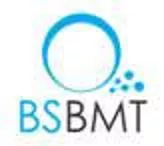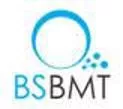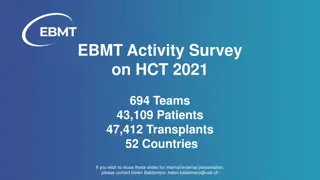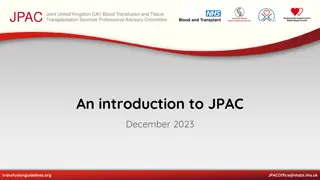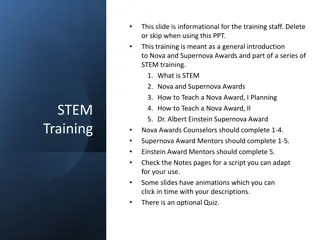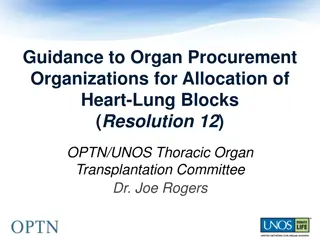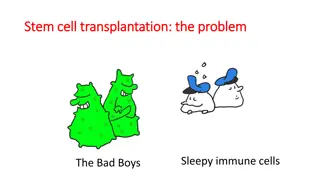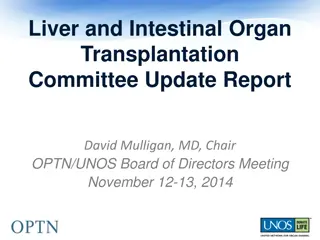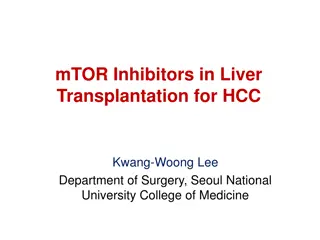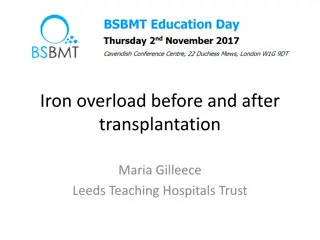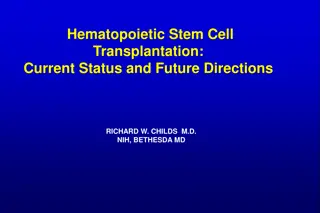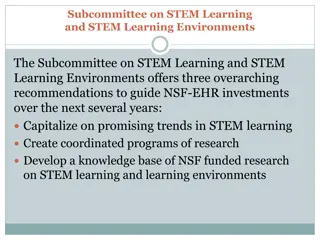Community Programs for Outcome Data Analysis in Stem Cell Transplantation
A suite of community-contributed programs is utilized by the British Society of Blood and Marrow Transplantation at Guy's Hospital to analyze demographic and survival data related to stem cell transplantation. The programs aim to produce outcome tables and graphs that aid in retrospective studies, including comparisons of chemotherapy procedures, the feasibility of certain transplant circumstances, and the utility of second transplants post-relapse. Requests for data summaries from healthcare entities are met through rigorous data analysis techniques, generating datasets and outputs for further analysis and reporting.
Download Presentation

Please find below an Image/Link to download the presentation.
The content on the website is provided AS IS for your information and personal use only. It may not be sold, licensed, or shared on other websites without obtaining consent from the author. Download presentation by click this link. If you encounter any issues during the download, it is possible that the publisher has removed the file from their server.
E N D
Presentation Transcript
A suite of community-contributed programs to produce outcome tables and graphs for demographic and survival data Rachel Pearce British Society of Blood and Marrow Transplantation Guy s Hospital
Background BSBMT is an organisation for professionals with an interest in haematopoeitic stem cell transplantation Registry of all transplants performed in UK (subject to consent) + some Republic of Ireland Data mostly used for retrospective studies, e.g. Comparison of chemotherapy Whether the procedure is practical in certain circumstances (age / comorbidity / disease) Whether a second transplant is useful in the event of relapse after a first one These retrospective studies are methodically set up, data are checked and analyses are rigorously performed
Requests from NHSE for summaries of data Routine and ad hoc e.g. How many transplants of a given type in the last 5 years? How many of these were from sibling donors? How many had Reduced Intensity Conditioning? What ages were they? How many are still alive? How many died from non-relapse cause?
Two sorts of programs developed Programs to generate datasets: take Registry data and create summary tables as Stata datasets Programs to generate outputs: combine these datasets into datasets suitable for output to a Word file via putdocx
Programs to generate datasets All generate values for each level of the factor and for the total 1. medianbyfactor : medians of e.g. age or time to discharge from hospital 2. binarybyfactor : numbers and percentages of a given binary variable 3. osbyfactor : overall survival and 95% confidence interval at various time points 4. nrmbyfactor : as for osbyfactor but for non-relapse mortality 5. fubyfactor : as for osbyfactor but for follow up
Programs to generate output These programs use output from osfactor etc. and combine them: 1. factortables : combine some of the above into a table showing demographic and outcome data 2. factorgraph : produces a graph comparing two levels of a factor giving Ns and P values 3. tablegraph : produces a table (calling factortable) and overall survival (OS) graph for the same factor, appropriately labelled 4. centregraphs : to produce OS curves comparing a centre with the rest of the Registry
Example 1: Prospective trial proposed to discover the prognostic value of a particular test Specific population with a particular diagnosis Test only recently available; presence of indicator is speculated to have poor prognosis Trial design to establish this requires estimate of 2y OS in each case I was able to swiftly estimate the baseline survivals in the two subpopulations and graphically illustrate them
Prognostic marker Total Alive in CCR Alive post relapse Relapse death Non relapse death Engraftment failure % engraftment failure Median engraftment time (d) % OS at 1y 95% c.i. min 95% c.i. max % OS at 2y 95% c.i. min 95% c.i. max % NRM at 100d 95% c.i. min 95% c.i. max % NRM at 1y 95% c.i. min 95% c.i. max % NRM at 2y 95% c.i. min 95% c.i. max Absent Present 124 102 15 4 3 17 14 12 93 85 97 93 85 97 3 1 7 4 1 9 4 1 9 Total 210 159 86 57 16 7 6 11 13 12 88 77 94 81 65 90 5 2 12 11 5 20 11 5 20 31 11 9 28 13 12 91 85 95 87 79 93 Autologous transplant patients by prognostic status Output from tablegraph 4 2 7 7 4 12 7 4 12
OS by prognostic marker
Example 2: Outcomes by centre Asked to report numbers and outcomes by centre, by diagnosis and by type of transplant Need to compare outcomes with UK standard Reasonable comparisons require stratification / risk adjustment
From centre report
Thanks Rest of the Registry Team Physicians and Data Managers at all the centres which contribute data Fellow Stata users on Statalist and Twitter Patients who consent for their data to be used Rachel Pearce, Guy s Hospital rachel.pearce@kcl.ac.uk





